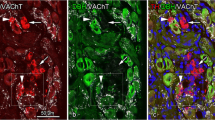Abstract
In the cynomolgus monkey, motoneurons innervating the levator palpebrae superioris muscle form a nucleus within the oculomotor nuclei called the central caudal nucleus. After double fluorescent neuronal retrograde tracing experiments, using fast blue and diamidino yellow as tracers in the levator palpebrae superior muscles, labelled motoneurons (30%) were found in an unpaired central caudal nucleus. Approximately 2% of the labelled motoneurons were double-labelled. The labelled and double-labelled neurons were distributed randomly over the central caudal nucleus, lateralization of populations of levator motoneurons within this nucleus was not observed. The afferent innervation of the levator palpebrae superioris muscle was restricted to the ophthalmic branch area of the gasserian ganglion. Primary afferent labelled neurons were absent from mesencephalic nucleus of the fifth nerve. Surprisingly, fast blue was also found in the ophthalmic branch area of the contralateral ganglion of Gasser, while diamidino yellow was present only ipsilaterally. About 1% of the afferent labelled neurons were double-labelled. The results reveal that in the cynomolgus monkey the central caudal nucleus is not only topographically but also functionally one nucleus. Afferent innervation of the levator palpebrae superioris muscle is probably bilaterally organized.
Similar content being viewed by others
References
Akagi Y (1978) The localization of the motor neurons innervating the extraocular muscles in the oculomotor nuclei of the cat and rabbit, using horseradish peroxidase. J Comp Neurol 181:745–762
Aramideh M, Ongerboer de Visser BW, Bour LJ, Devriese, PP, Speelman JD (1994) Electromyographic features of levator palpebrae superioris and orbicularis oculi muscles in blepharospasm. Brain 117:27–38
Aramideh M, Ongerboer de Visser BW, Koelman JHTM, Speelman JD (1995) Motor persistence of orbicularis oculi muscle in eyelid-opening disorders. Neurology 45:897–902
Augustine JR, Deschamps EG, Ferguson JG (1981) Functional organization of the oculomotor nucleus in the Baboon. Am J Anat 161:393–403
Baljet B, VanderWerf F, Otto AJ (1989) Autonomic pathways in the orbit of the human fetus and the rhesus monkey. Doc Ophthalmol 72:247–264
Björk A, Kugelberg E (1953) The electrical activity of the muscles of the eyes and eyelids in various positions and during movement. Electroencephalogr Clin Neurophysiol 5:595–602
Buisseret-Delmas C, Buisseret P (1990) Central projections of extraocular muscle afferents in cat. Neurosci Lett 109:48–53
Courville J (1966) The nucleus of the facial nerve: the reltion between cellular groups and peripheral branches of the nerve. Brain Res 1:338–354
Evinger C (1988) Extraocular motor nuclei: location, morphology and afferents. In: Büttner-Ennever JA (ed) Neuroanatomy of the oculomotor system, vol. II. Elsevier Science, Amsterdam, pp 81–119
Evinger C, Manning KA, Sibony PA (1991) Eyelid movements. Mechanisms and normal data. Invest Ophthalmol Vis Sci 32:387–400
Fuchs AF, Becker W, Ling L, Langer TP, Kaneko CRS (1992) Discharge patterns of levator palpebrae superioris motoneurons during vertical lid and eye movements in the monkey. J Neurophysiol 68:233–243
Gordon G (1951) Observations upon the movements of the eyelids. Br J Ophthalmol 35:339–351
Guerra-Seijas MJ, Labandeira Garcia JL, Tobio J, Gonzalez F (1993) Neurons located in the trigeminal sensory complex and the lateral pontine tegmentum project to the oculomotor nucleus in the rabbit. Brain Res 601:1–13
May PJ, Baker R (1987) Bilaterality of the sensory and motor pathways underlying blinking. Soc Neurosci Abstr 113:174
Murphy EH, Garone M, Tashayyod D, Baker RB (1986) Innervation of extraocular muscles in the rabbit. J Comp Neurol 254:78–90
Nashold BS, Seaber JH (1972) Defects of ocular motility after stereotactic midbrain lesion in man. Arch Ophthalmol 88:245–248
Payne JN (1987) Comparisons between the use of true blue and diamidino yellow as retrograde tracers. Exp Brain Res 68:631–642
Porter JD (1986) Brainstemtterminations of extraocular muscle primary afferent neurons in the monkey. J Comp Neurol 247:133–143
Porter JD, Spencer RF (1982) Localization and morphology of cat extraocular muscle afferent neurons identified by retrograde transport of horseradish peroxidase. J Comp Neurol 204:56–64
Porter JD, Guthrie BL, Sparks DL (1983) Innervation of extraocular muscles: localization of sensory and motor neurons by retrograde transport of horseradish peroxidase. J Comp Neurol 218:208–219
Porter JD, Burns LA, May PJ (1989) Morphological substrate for eyelid movements: innervation and structure of primate levator palpebrae superioris and orbicularis oculi muscles. J Comp Neurol 287:64–81
Sacks JG (1983) Peripheral innervation of extraocular muscles. Am J Ophthalmol 95:520–527
Schmidtke K, Büttner-Ennever JA (1992) Nervous control of eyelid function: a review of clinical, experimental and pathological data. Brain 115:227–247
Sekiya H, Kojima Y, Hiramoto D, Mukuno K, Ishikawa S (1992) Bilateral innervation of the musculus levator palpebrae superioris by single motoneurons in the monkey. Neurosci Lett 146:10–12
Spencer RF, Porter JD (1988) Structural organization of the extraocular muscles. In: Büttner-Ennever (ed) Neuroanatomy of the oculomotor system, vol II. Elsevier Science, Amsterdam, pp 33–81
VanderWerf F, Baljet B, Prins M, Timmerman A, Otto AJ (1993) Innervation of the supporier tarsal (Müller’s) muscle in the cynomolgus monkey: a retrograde tracing study. Invest Ophthalmol Vis Sci 34:2333–2340
Warwick R (1953) Representation of the extraocular muscles in the oculomotor nuclei of the monkey. J Comp Neurol 98:449–504
Author information
Authors and Affiliations
Corresponding author
Rights and permissions
About this article
Cite this article
VanderWerf, F., Aramideh, M., Ongerboer de Visser, B.W. et al. A retrograde double fluorescent tracing study of the levator palpebrae superioris muscle in the cynomolgus monkey. Exp Brain Res 113, 174–179 (1997). https://doi.org/10.1007/BF02454155
Received:
Accepted:
Issue Date:
DOI: https://doi.org/10.1007/BF02454155



